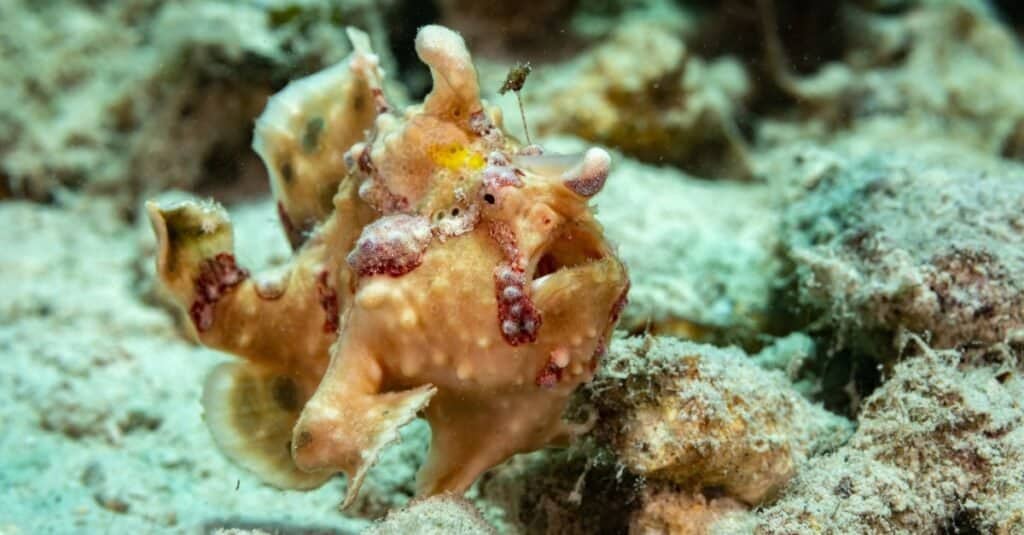Anglerfish
.jumbotron {
background-image: url(“https://a-z-animals.com/media/2021/08/Anglerfish-header-400×300.jpg”);
}
}
@media only screen and (min-width: 641px) and (max-width: 920px) {
.jumbotron {
background-image: url(“https://a-z-animals.com/media/2021/08/Anglerfish-header-470×370.jpg”);
}
}
@media only screen and (min-width: 921px) {
.jumbotron {
background-image: url(“https://a-z-animals.com/media/2021/08/Anglerfish-header.jpg”);
}
}
Anglerfish
The anglerfish has a glowing lure on its head to attract unsuspecting prey
Anglerfish Scientific Classification
Read our Complete Guide to Classification of Animals.
Anglerfish Conservation Status
Anglerfish Facts
- Prey
- Crustaceans and fish
- Group Behavior
-
- Solitary
- Fun Fact
- The anglerfish has a glowing lure on its head to attract unsuspecting prey
- Estimated Population Size
- Unknown
- Most Distinctive Feature
- The lure
- Other Name(s)
- Seadevils
- Gestation Period
- Up to a few weeks
- Diet
- Omnivore
This post may contain affiliate links to our partners like Chewy, Amazon, and others. Purchasing through these helps us further the A-Z Animals mission to educate about the world’s species..

Spiders that fly! Fish that walk! And 1000+ more incredible animals. Discover them all for FREE
.photo-gallery {
–margin: 0px auto 0px;
–padding: 0px 0px 0px 0px;
}
.gallery-link {
background-image: url(“https://a-z-animals.com/media/2021/08/Anglerfish-on-black-1024×535.jpg”);
background-repeat: no-repeat;
background-size: cover;
background-position: center;
height: 500px;
justify-content: center;
text-align: center;
align-items: center;
display: flex;
border: 2px solid #000;
}
.gallery-link img {
height: 50%;
}
@media only screen and (max-width: 768px) {
.gallery-link {
height: 300px !important;
}
}
View all of the Anglerfish images!
The anglerfish is an order of deep-sea predators, some of them living at depths of more than 6,000 feet where sunlight is almost completely absent.
This marine creature is very well-known for its bizarre appearance, sharp fangs, and bioluminescent lure extending from the top of the head, making it a truly rare deep sea creature. This lure is perhaps the most important of its adaptations. Filled with light-emitting bacteria, it draws in unsuspecting prey while the fish lies in wait to nab them. The technical term for the lure is the illicium.
3 Incredible Anglerfish Facts!
- Based on genetic analysis, it’s thought that the anglerfish first evolved in the Cretaceous Period, some 100 to 130 million years ago.
- The lure of the “fishing rod” is actually a modified spine of the dorsal fin.
- One of the most interacting facts is that some species of anglerfish have glowing bioluminescent organs in addition to the light from their “fishing rods.” These might be adaptations to help them navigate in the dark.
Anglerfish Classification and Scientific Name
The scientific name of the anglerfish is Lophiiformes. This derives from the Greek word lophius, meaning crest.
Anglerfish Species
There are more than 200 documented species of anglerfish spread across 11 different families. These are some of the best-known types.
- Humpback Anglerfish: This species was one of the first anglerfish ever discovered and still shapes perceptions of what an anglerfish looks like. Featuring sharp fangs and a long lure, it stalks the ocean down to its depths.
- Monkfish: The monkfish, also known as a goosefish, is a family of anglerfish that inhabits continental shelves closer to the surface, making it accessible for humans to catch. The angling rod is located closer to the mouth than other types of anglerfish
- Frogfish: This is a family of tropical fish whose body is covered in all manner of unique spines, thorns, appendages, and even algae to aid in camouflage and lure in prey. Some species even have the ability to change colors to match the surrounding environment. They almost resemble the stones or coral they swim among.
Anglerfish Appearance
The anglerfish comes in all sorts of strange shapes and sizes. While the round appearance is most well-known, some species are very long or even angular. Their crescent-shaped mouths bear many prominent fangs, angled inward to capture prey. Some species also have a muscular skin flap on the top of the head to hide or reveal its glowing lure; the lure itself can be straight, curved, or hooked. Their color normally ranges anywhere between dark brown and gray, but some are green-yellow, and red as well.
The anglerfish has one of the strongest sexual differences in the entire animal kingdom. The male is much smaller than the female and may not have a lure. Sometimes he even looks like a completely different species. While males only measure about an inch long, the female can reach up to 4 feet in size (though most are only a foot or two long).

Gerald Robert Fischer/Shutterstock.com
Anglerfish Distribution, Population, and Habitat
The anglerfish is found worldwide, from continental shelves all the way down to the seafloor. While many are listed as least concern, it’s difficult to perform an accurate population assessment on them because of the extreme depths of their habitats.
Anglerfish Predators and Prey
The anglerfish sits near the top of the food chain in its deep-sea habitat, where few other large predators roam.
What eats the anglerfish?
The anglerfish seems to have very few predators in its natural habitat besides humans and maybe some larger fish (like sharks).
What does the anglerfish eat?
Crustaceans and fish (shrimp in particular) form the bulk of their diet. In order to capture its prey, the anglerfish will often pulse the light and move it back and forth in the water. Some species are so voracious they’ve been documented eating prey as large as their entire bodies.
Anglerfish Reproduction and Lifespan
The anglerfish has evolved two distinctive reproductive strategies. The first and more traditional method of reproduction involves external fertilization. Although the pair forms a close physical union together, the female will release her eggs into the water, while the male will release his sperm to fertilize them. The male is then free to reproduce again with another female.
The second method is one of the most unique reproductive adaptations in the entire animal kingdom. This involved a fully symbiotic relationship between the mating pair. When the male finds a suitable mate, he will bite into her flesh and begin the process of fusing with her body down to the blood-vessel level. In exchange for sperm, he will receive nutrients directly from the female’s body. Males of these species might have highly undeveloped anatomy; they often have trouble finding food on their own, before attaching it to a mate, whom they depend on for sustenance. There are several theories for how this unique strategy evolved. One leading theory is that it evolved in response to low population density when the chances of finding another mate are low.
Regardless of the reproductive method, the rest of the development proceeds in a similar manner. A single female anglerfish can release millions of eggs, usually covered in a gelatinous substance. Gestation can take anywhere between a few days and a few weeks at a time until the eggs are ready to hatch. Unfortunately, there are still a lot of facts we don’t know about early anglerfish development. Presumably, given the number of eggs produced, early attrition among juveniles is quite high. The few fish that do survive into adulthood have a solid lifespan. Some of the females can live up to 25 years in the wild.
Anglerfish in Fishing and Cooking
The deep-sea anglerfish is not very common in either recreational or commercial fishing. However, the goosefish from the family Lophiidae is considered to be a delicacy in many parts of the world. Their flesh can be steamed, sauteed, broiled, fried, and baked.
View all 127 animals that start with A
Anglerfish FAQs (Frequently Asked Questions)
Where are anglerfish found?
Anglerfish are found all over the world, largely in deep tropical and temperate waters, but their extreme depths ensure that they rarely come into contact with people.
Are anglerfish blind?
While some species may have poor eyesight, none of them is completely blind. Most anglerfish actually have specialized eyes for seeing in deep-sea habitats.
Why are anglerfish so scary?
The anglerfish have sharp fangs and a bizarre, grizzled appearance; their isolated deep-sea habitat also makes them seem a little scary. But while they are voracious predators, they’re just like any other animal.
Do anglerfish still exist?
Yes, there are more than 200 species, most of them listed as least concern.
Do anglerfish bite humans?
Anglerfish rarely interact with humans in any meaningful way, but presumably, if they felt threatened, they could bite.
What is the biggest anglerfish ever found?
The biggest anglerfish ever found was more than 4 feet long.
Sources
- Oceana, Available here: https://oceana.org/marine-life/ocean-fishes/deep-sea-anglerfish
- Britannica, Available here: https://www.britannica.com/animal/anglerfish
















